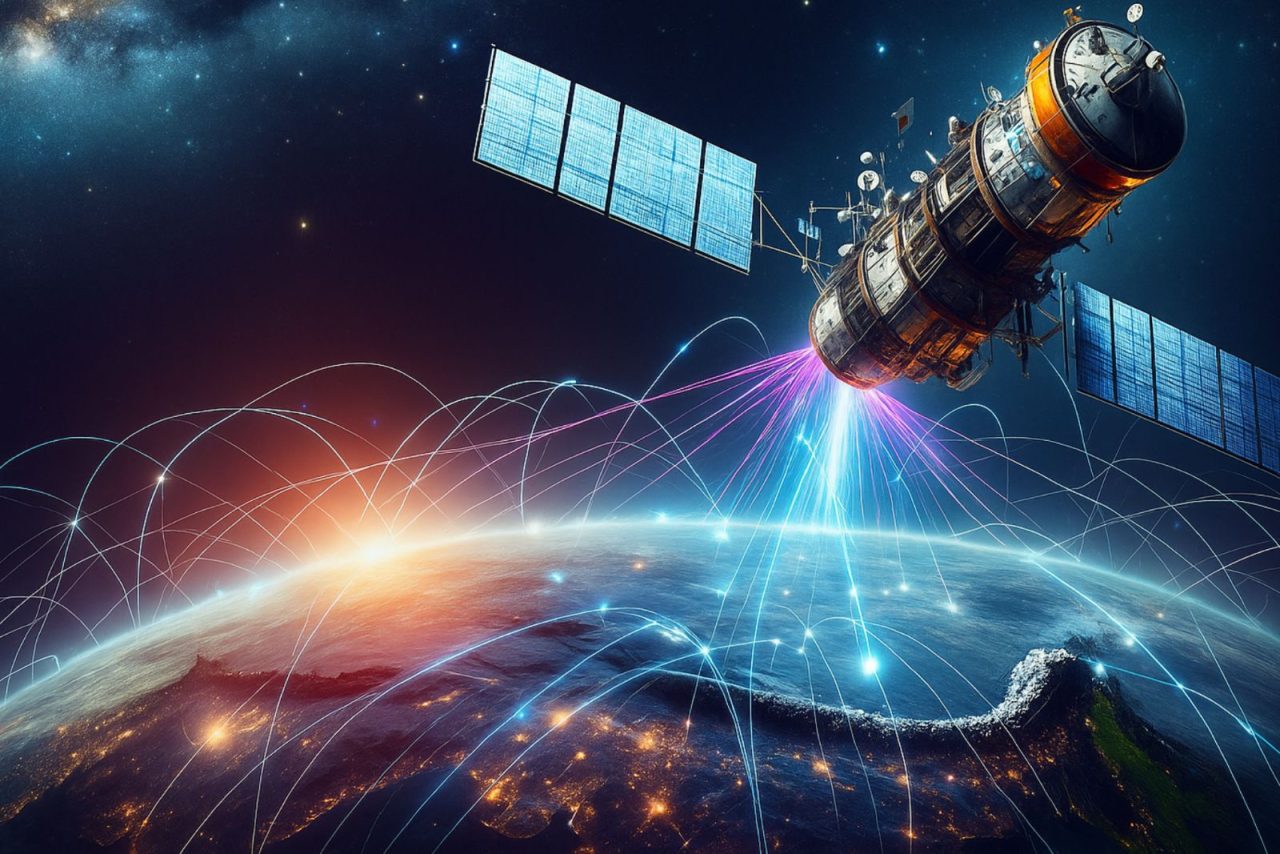India is on the verge of a transformative leap in connectivity and digital empowerment. For decades, satellite communication (Satcom) was regarded as a peripheral technology, deployed largely for defence, disaster response, and niche sectors such as broadcasting. The average citizen rarely felt its impact. However, that is quickly changing.
By December 2025, India is expected to approve and enable the commercial rollout of multiple Low Earth Orbit (LEO) satellite networks, including Bharti-backed Eutelsat OneWeb, Reliance Jio-SES, SpaceX’s Starlink, Amazon Kuiper, and a new crop of Indian startups supported by ISRO (Indian Space Research Organisation). These constellations, orbiting between 500 and 2,000 km from Earth, is capable of bringing high-speed, low-latency connectivity to every corner of the country—from Himalayan villages and desert hamlets to oceanic islands and cyclone-prone deltas.
Unlike traditional geostationary satellites, which orbit at 36,000 km above the equator and often suffer from latency and coverage limitations, LEO satellites promise near-fibre-like performance. This is not just about plugging coverage gaps; it is about reshaping India’s development trajectory, enabling national missions like Digital India and BharatNet while enhancing education, healthcare, agriculture, disaster management, defence, and economic inclusivity.
For the first time, India has the technology, the policy environment, the private investment appetite, and the demand conditions to make Satcom a true force-multiplier for inclusivity.
The Expanding Indian Space Economy
India’s space economy is already undergoing rapid transformation. According to the IN-SPACe Decadal Vision, the sector could reach USD 44 billion by 2033, with Satcom contributing nearly USD 14.8 billion, representing 8 per cent of the global market. Several drivers are converging to make this growth inevitable:
(i) Policy Evolution
Government policy has been instrumental in opening up the sector. The establishment of IN-SPACe (Indian National Space Promotion and Authorisation Centre) created a transparent interface between ISRO, private players, and regulators. FDI and Draft Space Policy 2023 ensured clarity for private enterprises to invest in launches, satellites, and ground infrastructure.
(ii) Private Investment and Partnerships
Indian conglomerates like Bharti Enterprises, Reliance Jio, and Larsen & Toubro have made significant commitments in Satcom ventures. Meanwhile, startups such as Pixxel, Dhruva Space, and Piersight are innovating in earth observation, satellite hardware, and applications. Together, they are creating an ecosystem of ground stations, user terminals, and sector-specific services.
(iii) Global Collaborations
India’s Satcom trajectory is also strengthened by partnerships with global leaders. SpaceX’s Starlink, SES, Hughes, Airbus, and Amazon Kuiper bring advanced technologies, investment, and experience. With local manufacturing incentives, these partnerships can lower equipment costs and foster technology transfer.
(iv) Demand Surge
India has more than 800 million internet users, but the Telecom Regulatory Authority of India (TRAI) reports that as of March 2025, a 66 per cent digital divide persists, with only one-third of citizens enjoying reliable, high-quality access. The convergence of policy, investment, collaboration, and demand means Satcom is now positioned not as an auxiliary but as a central pillar of India’s digital future.
December 2025: The Satcom Tidal Wave
By the end of 2025, India is expected to witness the simultaneous entry of several major Satcom operators:
- Eutelsat OneWeb: It already has hundreds of satellites in orbit and strong institutional partnerships in India, targeting government and enterprise users.
- Reliance Jio-SES: It combines Jio’s distribution network with SES’s satellite technology to serve both consumer and vertical markets.
- Starlink (SpaceX): With its global presence, Starlink aims for mass adoption in rural areas, promising plug-and-play user terminals.
- Amazon Kuiper: The world’s largest ecommerce firm will bring cost-effective broadband integrating Amazon’s vast e-commerce, cloud, and logistics ecosystems.
- New Indian Entrants: Startups and public-private consortia focusing on earth observation, communications, and sector-specific applications.
Together, these players will deliver a capacity, reaching territories long written off as commercially unviable for fibre or mobile networks. Satcom will not compete directly with 5G or fibre; rather, it will complement and extend them, ensuring resilience and inclusivity across the country.
Satcom’s Transformative Impact on Inclusivity
(i) Bridging the Digital Divide
In India, rural internet penetration remains around 37%, compared to more than 70% in urban centres. Millions of villages, schools, and local businesses still operate offline. LEO Satcom collapses these barriers. True inclusivity: technology that does not discriminate by geography or infrastructure budgets will be enabled by the SATCOM.
(ii) Empowering National Missions
Satcom serves as a powerful enabler for India’s flagship national programs by extending reliable, high-speed connectivity to regions that remain outside the reach of terrestrial networks. It strengthens Digital India and BharatNet by helping connect the “last 100,000 villages” still beyond the fibre grid, while advancing Skill India and Education through real-time virtual classrooms, remote teacher training, and AI-driven learning platforms that democratize quality education. Under the Ayushman Bharat Digital Mission, Satcom supports telemedicine, electronic health records, and diagnostic consultations in underserved areas lacking doctors. In agriculture, it empowers farmers with IoT-enabled precision farming tools, timely weather forecasting, soil monitoring, and access to digital marketplaces. Finally, Satcom bolsters smart governance by equipping Panchayats and municipal bodies with the ability to deliver e-services efficiently and engage citizens directly, thereby fostering inclusive and participatory development across the nation.
(iii) Disaster Management
India faces frequent natural disasters such as cyclones, floods, earthquakes, and landslides, where terrestrial networks are often the first to collapse, disrupting communication at critical moments. Satcom provides a disaster-resilient backbone by enabling real-time alerts, seamless coordination of emergency responders, drone-based surveillance, and efficient relief logistics even in complete blackout zones. Beyond disaster management, Satcom is equally vital for defence and national security, ensuring secure communications for troops in remote border regions like Ladakh and Siachen, supporting surveillance and UAV operations with real-time intelligence and navigation, and offering resilient backups that maintain command continuity during cyberattacks or terrestrial network failures. Furthermore, with localisation requirements and indigenous participation, Satcom enhances India’s sovereignty and self-reliance, ensuring national control over critical strategic infrastructure.
(iv) Economic Empowerment
Satcom is not just about delivering information—it is about creating livelihoods and unlocking economic potential at the grassroots. In traditional sectors, fisherfolk benefit from real-time weather updates, navigational support, and access to digital marketplaces, while artisans and craftspeople can expand their reach through e-commerce platforms. For small enterprises, particularly women-led businesses and rural startups, Satcom opens doors to wider markets, reliable logistics, and mobile payment systems that enable them to scale beyond local boundaries. It also drives financial inclusion by bringing digital banking, micro-credit, and fintech innovations to unbanked populations that have long been excluded from formal finance. Here, inclusivity goes beyond connectivity—it translates into active participation in the national growth story, empowering communities to contribute meaningfully to India’s economic progress.
LEO Technology: The Game-Changer
Traditional Geostationary Orbit (GEO) satellites, positioned at about 36,000 km above Earth, have long struggled with latency rates exceeding 600 ms, constraining their effectiveness for broadband and real-time applications. In contrast, Low Earth Orbit (LEO) satellites operate at much lower altitudes of 500–2,000 km and deliver significant technical advantages: latency drops sharply to around 20–40 ms—comparable to fibre connections; capacity scales up dramatically as thousands of satellites form robust, interconnected constellations; and dynamic beam steering enables rapid redirection to high-demand regions. Together, these advances make LEO satcom networks uniquely suited to India’s soaring data consumption demands, from streaming and cloud services to IoT and AI-powered platforms
The Triple Imperative: Policy, Price, Partnerships
India’s satellite communication (Satcom) policy landscape is evolving swiftly, but key challenges remain unresolved and must be addressed for successful national adoption. The allocation of spectrum stands out as a major question—whether to auction or administratively assign bands continues to generate debate, impacting industry certainty and investment. A unified licensing framework is needed to ensure a level playing field for global corporations and domestic startups alike, fostering innovation while maintaining regulatory equilibrium. Data sovereignty provisions—such as mandatory localisation and real-time tracking—strengthen national security but must be calibrated to allow operational flexibility for service providers. Coordinated regulation among India’s main authorities—the Department of Telecommunications (DoT), ISRO, TRAI, and IN-SPACe—remains critical to avoid conflicting mandates or procedural delays that could hamper sector growth.
Affordability is another pivotal factor in Satcom’s inclusivity. With user terminals currently priced between INR 30,000 and 50,000, large segments of rural and lower-income households risk exclusion unless prices fall further. Approaches for cost reduction include public subsidies via the Universal Service Obligation Fund (USOF), incentives for domestic manufacturing under Production-Linked Incentive (PLI) schemes, and tiered pricing models tailored for diverse user groups—from households and schools to enterprises and specialised users. Notably, the mobile telephony revolution in India shows that competitive scale and lowered initial barriers can quickly drive prices down and broaden access.
Finally, partnerships are essential for Satcom inclusion. Collaboration between public agencies like ISRO and private actors is needed for launches and establishing terrestrial infrastructure, while effective industry-academia alliances are crucial to cultivating a skilled Satcom workforce for future innovation. International technology partnerships play a vital role, so long as they are harmonised with India’s self-reliance ambitions under Atmanirbhar Bharat.
Challenges and Caveats
The journey toward widespread satellite communications in India faces several substantial challenges that need strategic solutions. First, the high cost of equipment—especially user terminals—may marginalize rural and small users unless targeted subsidies are implemented. The deployment of thousands of Low Earth Orbit satellites heightens concerns over space debris, demanding sophisticated orbital traffic management to ensure safety and sustainability. Additionally, the involvement of multiple regulatory agencies increases the risk of overlaps and delays, which could impact project timelines and market entry. As Satcom networks grow, cybersecurity becomes a critical focus, with systems needing resilience against interception and spoofing to safeguard user data and national interests. Finally, achieving robust interoperability is essential: seamless integration with terrestrial 5G and future 6G networks will be vital to delivering reliable connectivity and a uniform user experience as technology continues to evolve.
Conclusion: Seizing India’s Satcom Moment
December 2025 is more than a date—it is a turning point. With Satcom, India can dissolve its digital divide and replace it with a digital dividend. The technology is proven, the players are ready, and the demand is urgent. What remains is ensuring clear policy, affordable pricing, and strategic partnerships.
If these elements align, Satcom will revolutionise India’s growth story—binding together aspirations from the Himalayan peaks to the Andaman shores. In the 21st century, satellites will not just orbit above; they will orbit within daily life, powering inclusivity, empowerment, and national progress.
India’s destiny, and its global leadership, may well be written through connectivity that reaches everyone, everywhere.


